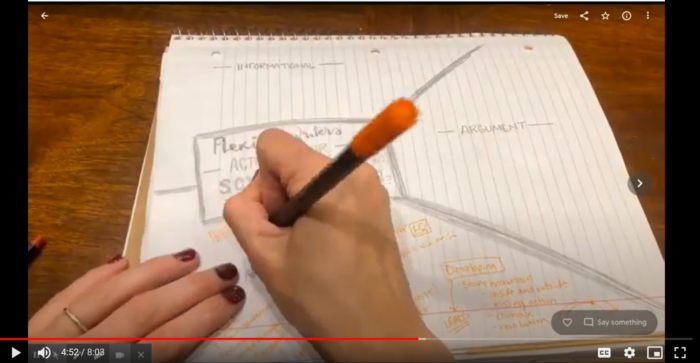“Hi Writers! I am so excited to get to write with you today. I wish I could see you in person, but I am so excited to get those words out of you.” So begins lab host (and staff developer), Kirsten Meyers Blake’s introduction to her fifth graders’ writer’s workshop for the day. Kirsten believes deeply in her students and their abilities as readers, writers, and THINKERS. She leverages her mini-lessons to foster community by creating a shared virtual space that allows students the freedom and opportunity to get smarter together.
For each day’s online writing workshop, Kirsten’s mini-lesson serves not only to set students up for the independent work time portion of their lesson, but also to help students feel connected during this time of remote learning. So, how does she blend cognitive and emotional engagement during her mini lesson?
1. Providing Clear Agreements for Digital Work Time
In her physical classroom, Kirsten uses anchor charts to remind students of expectations for independent learning and work time. In her remote classroom, she uses a piece of paper and sticky notes that illustrate the expectations for “digital work time.” As she describes each of these agreements via video conference with students, she explains what successful adherence to them might look and sound like. This clarity supports students in building their own agency to create their own conditions for successful remote learning at home.
These agreement include:
- Find a quiet space
- Honor our time – be present for the lesson
- Have materials out
- Be ready to think
2. Using Personal Stories
After reviewing the agreements, Kirsten shares a story about her close friend in another city and uses this to explain what writers do when they are returning to their craft after time away. (Students are just returning after spring break.) Kirsten gives students the space to enter back into the remote learning environment and supports their success by reviewing the thinking strategy of schema. She says, “When writers have taken time away from writing, they have to pause…. We have to activate our schema and ask ourselves, ‘What do I already know?’” Her idea of pause serves to not only reinforce to students that it’s okay to take a risk, but that all learners use schema throughout their lives to connect, engage, and make meaning on a daily basis- just as Kirsten does when she reaches out to a friend she hasn’t talked with in a long time.
3. Showing AND not just Telling
Kirsten states, “Here is our teaching point today,” and then proceeds to SHOW students on a sticky note with the purpose of the mini-lesson written, “Before they write, writers activate their schema. They remember all they know about narrative writing.” As she continues with the lesson, Kirsten sets her paper up while on the video, providing students a visual of the process she uses to capture her thinking. This matters as it puts an emphasis on the learning process and not the end goal or a right answer. This modelling supports equity and access for all her students, who may be at different places in their learning journey.
Kirsten also shares with students that their thinking and writing will look different, which supports them to take risks and, again, fosters a community of learners where all students know their role is to work together to get smarter. Kirsten skillfully uses students’ schema to support them as they move into a new genre of writing, building their confidence and helping them to be independent learners in this time of distance learning. She pauses during the video and provides students with time and space to “catch their thinking.” Kirsten names that she is moving through the writing process. All these instructional moves, in addition to the music Kirsten plays, parallel the experience that students would have in her classroom.
3. Buttoning up
As the mini-lesson comes to a close, Kirsten reinforces the teaching point by illustrating with personal examples and reminding students that being a flexible writer includes, “Asking ourselves, what do I already know?“ She returns to the thinking strategy of schema as a reminder that this can support students’ independence.
Finally, Kirsten closes the mini-lesson by summarizing her time on the video and reminding students of their independent work time task. “Today we activated our schema, and we remembered everything we knew about narrative writing. I’d like you to spend some time making your sketch note pretty. Take some time looking at it, making sure you haven’t missed anything… I am going to share with you a folder (containing) some of our anchor charts.” Finally, she signs off for the day, “I will see you tomorrow in Writer’s Workshop,” communicating to students that while she may be there physically, she is with them in their hearts and minds.
Kirsten’s mini-lesson is just one example of how teachers all over the country are leveraging both the power of personal teaching videos and thinking strategies to set students up for success during remote learning. These types of videos can be used during synchronous or asynchronous learning as think time, modeling structures for holding thinking, and showing the “how” of the work of thinking. In these ways, carefully planned remote learning can serve to support the continued cognitive and emotional engagement of learners.

